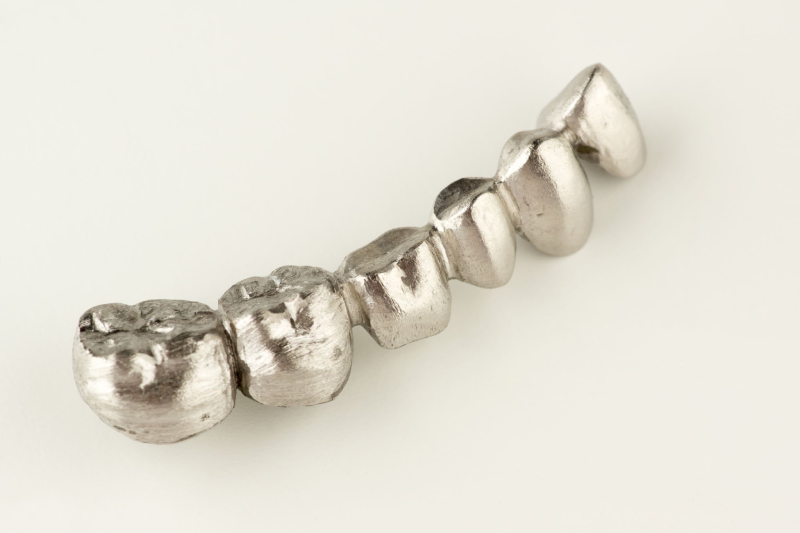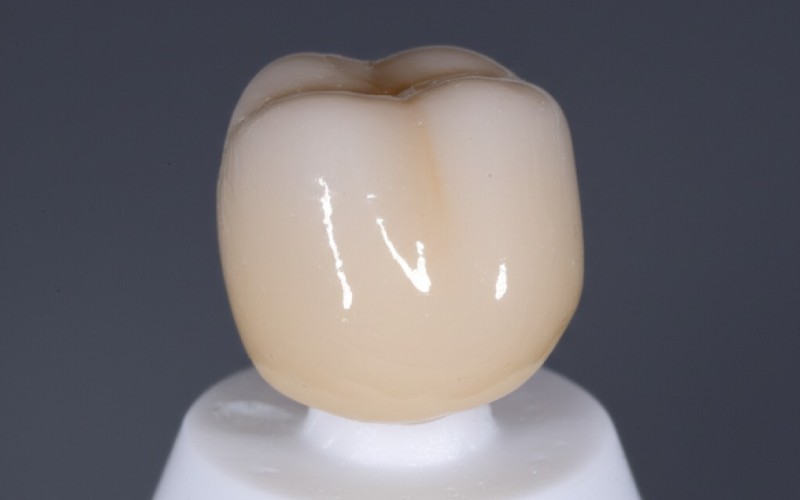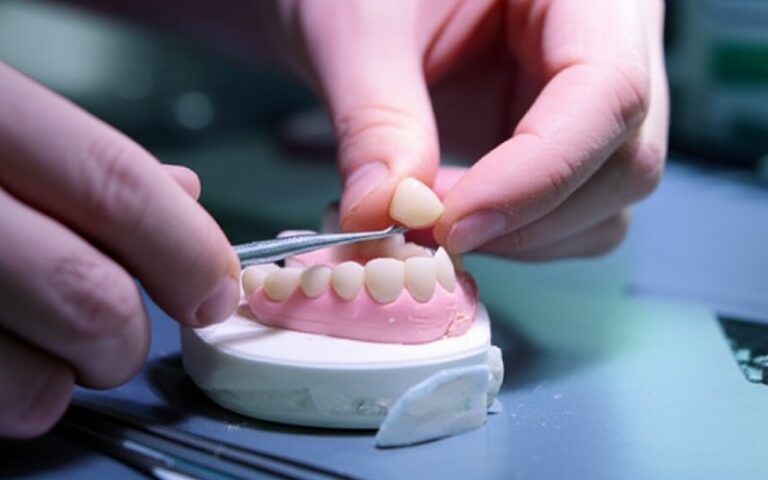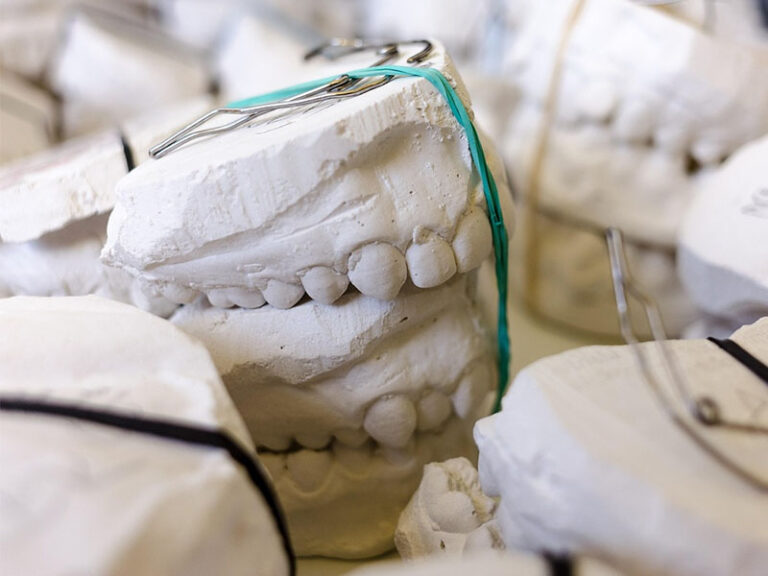
PFM Crown Alloys: Guide til ædelmetal vs. ikke-ædelmetal for en holdbar tandkrone
This article will help you understand the metal used in your PFM-krone. We will look at how the metal alloy affects how long your crown lasts and how it feels in your mouth. Reading this will help you have a better talk with your dentist and make the best choice for your smile.
Indholdsfortegnelse
What Exactly Is a Porcelain-Fused-to-Metal (PFM) Crown?
Let’s start with the basics. A PFM crown is a type of dental crown that has been a popular choice for a long time. The “PFM” stands for porcelain-fused-to-metal. This name tells you exactly what it is. It’s a crown made of two parts. The inside part is a thin, strong metal shell that fits over your tooth. The outside part is a layer of tooth-colored porcelain. The porcelain is baked, or fused, onto the metal. This design gives you the strength of metal with the nice look of porcelain.
This special crown gives you the best of both worlds. The metal core, or metal substructure, makes the crown very strong. It can handle the force of biting and chewing. The outer layer of porcelain is matched to the color of your other teeth. This makes the crown look natural in your smile. So, a porcelain-fused-to-metal crown is a mix of strength and beauty. It’s a reliable dental restoration that dentists have trusted for many years. This type of crown is a great example of a sturdy prosthesis.
How is a PFM Dental Crown Made? The Fabrication Process Explained.
The fabrication of a PFM crown is a cool process. It all starts after your dentist prepares your tooth. Your dentist then takes a mold of the tooth. This mold is sent to a special place called a dental lab or a dental laboratory. There, skilled workers start making your new crown. They first create the metal framework. This is the strong base of the crown. This metal core has to fit your tooth perfectly.
Once the metal framework is ready, the next step is to add the porcelain. The lab technician carefully applies layers of porcelain paste onto the metal. Then, they bake the crown in a very hot oven. This high heat causes the porcelain to fuse to the metal. It becomes one solid piece. The technician may add several layers of porcelain to get the right shape and color. This process takes a lot of skill to make sure the final crown looks and feels right. The final PFM crown is a strong and beautiful dental restoration.
What is a High-Noble Alloy Used in the Fabrication of a Crown?
When we talk about the metal in a PFM crown, not all metals are the same. The metal part is actually an alloy, which is a mix of different metals. One type is called a high-noble alloy. The term “high-noble” sounds fancy, and for good reason. For a metal alloy to be called high-noble, it must have over 60% noble metal. Noble metals are things like gold, platinum, and palladium. At least 40% of that noble metal must be gold. This type of alloy used in the fabrication of a crown is often the top choice.
There are many good things about using high noble alloys. This precious metal mix is very kind to your body’s tissues. We call this biocompatibility. It is less likely to cause irritation or allergic reactions. Gold is also soft enough to create a very tight seal around the tooth. This helps prevent future decay under the crown. The high-noble metal alloy provides great support for the porcelain, making for a long-lasting crown. These precious metal alloys are often white or silver in color, though some have a yellow tint.

Are Non-Precious Metal Alloys a Good Choice for a Dental Restoration?
Now, let’s talk about the other main option: non-precious metal alloys. These are also called base metals. A non-precious alloy is one where noble metals make up less than 25% of its weight. Most non-precious alloys have no noble metals at all. Instead, they are made from metals like cobalt, chromium, nickel, and sometimes beryllium. These metals are very strong and hard.
Non-precious alloys have some benefits. The biggest one is cost. They are much cheaper than high-noble alloys. This can make the total cost of your dental crown lower. These metals are also very strong and resist breaking. This makes them a good choice for a molar crown that does a lot of heavy chewing. However, there are some things to think about. Some people can have metal allergies, especially to nickel. Non-precious alloys can also be harder for the dental lab to work with.
High-Noble vs. Non-Precious: Which Alloy Offers Better Durability?
The durability of your dental crown is very important. So, which metal alloy is more durable? Both high-noble and non-precious metal alloys make for a very durable crown. They are both much stronger than natural teeth when it comes to standing up to chewing forces. The metal core in any PFM crown provides excellent strength, which is why these crowns are still a popular choice for posterior teeth.
The main difference in durability comes down to how the alloy behaves over many years of use. High-noble alloys, because they contain gold, have a bit more flex. This can be gentler on the opposing teeth you bite against. Non-precious alloys are harder and more rigid. This makes them highly durable and resistant to wear, which is great for patients with bruxism (people who grind their teeth). In the end, both types of metal alloys create a strong restoration that can last for a very long time with good oral hygiene.
Can the Metal in a PFM Crown Affect My Gums?
This is a great question. The answer is yes, the metal in your PFM crown can affect your gums. This is where biocompatibility comes in again. Your gum tissue is very sensitive. A high-noble alloy is very biocompatible. This means your body and your gum tissue are very likely to accept it without problems. It is rare for someone to have a reaction to gold or platinum. This helps to maintain good periodontal health around the crown.
On the other hand, non-precious metals can sometimes cause issues. Some patients have metal allergies, most often to nickel. This can cause redness, swelling, or irritation in the gum around the crown. Another issue with any metal restorations, but more so with non-precious ones, is a dark line that can appear at the gingival margin, or gum line. This happens if the gum starts to pull back, or recede, showing the metal edge of the crown. A high-noble alloy is less likely to show a dark line if recession happens.
What Are the Potential Limitations of Choosing a PFM Crown?
While PFM crowns offer many advantages, it’s good to know about the potential limitations of choosing this type of crown. The biggest one is looks. While the porcelain layer is tooth-colored, it doesn’t let light pass through it the same way a natural tooth does. This is because the metal underneath is opaque and blocks light. This lack of translucency can make the PFM crown look a little less lifelike compared to all-ceramic crowns, especially on anterior teeth.
Another issue we just talked about is the dark line at the gum line. Over time, as gums naturally recede, the metal edge of the crown may become visible. This dark line is not a health problem, but some people do not like how it looks. Finally, to make room for both the metal and the porcelain, your dentist might need to remove a bit more of your natural tooth structure compared to some other types of crowns, like full metal crowns. Your dentist will talk with you about the advantages and disadvantages of each type of crown.
How Does a PFM Crown Compare to a Zirconia or All-Ceramic Crown?
In modern dentistry, we have more choices than ever before. Besides PFM crowns, you might hear about zirconia crowns or other all-ceramic crowns. So how do they compare? All-ceramic crowns are made entirely of a porcelain-like material. Their biggest benefit is their appearance. They have amazing translucency and look very much like natural teeth. This makes them a great choice for front teeth where looks are most important. However, some older all-ceramic crowns are not as strong as PFM crowns.
Then there’s zirconia. Zirconia is a very strong type of ceramic material. A zirconia crown is tooth-colored, very durable, and biocompatible. Zirconia crowns are a great mix of strength and beauty. They don’t have a metal core, so you never have to worry about a dark line at the gum. Zirconia can be a good choice for both posterior and anterior restorations. However, a PFM crown may still be a better choice in some cases, especially for long bridges where the strength of the metal framework is needed. The best choice depends on your specific dental needs.
Why is the Alloy Used in a PFM Crown So Important for Longevity?
You might be thinking, “It’s just a small piece of metal, does it really matter that much?” Yes, it does! The alloy used is key to the long life of your PFM crown. Think of the metal alloy as the foundation of a house. A strong, stable foundation leads to a house that lasts for decades. The same is true for your dental crown. A good metal alloy provides a strong and stable base for the porcelain to fuse to.
The way the porcelain and metal bond is very important. High-noble alloys bond very well with porcelain. This strong bond prevents the porcelain from chipping or breaking away from the metal. Also, the fit of the crown is key. High-noble alloys can be cast with amazing accuracy, leading to a crown that fits your tooth perfectly. This tight fit stops bacteria from getting under the crown and causing problems later. Choosing the right metal alloy from the start helps make sure your dental restoration gives you many years of good service.
How Do I Choose the Best Metal Alloy for My PFM Crown?
So, after all this information, how do you make the best choice? The first step is to talk with your dentist. Your dentist knows your specific dental situation, like which tooth needs a crown (a molar or a front tooth) and the health of your gums. They can tell you about the best options for you. If you have known metal allergies, be sure to tell your dentist. This will help them guide you away from certain non-precious alloys that contain nickel.
Think about what is most important to you. Is it the cost? Then a non-precious metal alloy might be a good option, especially for a back tooth that doesn’t show much. Is it the best possible biocompatibility and fit? Then a high-noble alloy is likely the best choice. PFM crowns are still a fantastic restorative option. By understanding the difference between the metal alloys, you can be a partner with your dentist in choosing the perfect crown for your health and your smile.

Things to Remember:
- A PFM crown has a strong metal core with a tooth-colored porcelain layer on top.
- The metal is an alloy, which is a mix of different metals.
- High-noble alloys contain precious metals like gold and are very biocompatible.
- Non-precious alloys are made of base metals like cobalt-chromium, are very strong, and cost less.
- The choice of alloy affects the crown’s look, its kindness to your gums, and its long-term success.
- Zirconia and all-ceramic crowns are other options that offer great looks but may not be right for every situation.
- Always talk to your dentist to decide on the best type of crown and metal alloy for your specific needs.




